How to share a printmaking practice, in a book, away from the studio
How do you demonstrate printmaking practice and process to people viewing your work in a gallery space when you’re not there yourself?
How do you make a personal connection with people interested in your work when you can’t be there to talk with them, about your practice or the work they are viewing?
And how do you explain the techniques, processes, complexities and time involved in creating an edition of prints.
How do you help people understand that printmaking prints ARE original fine art, and not simply reproductions?
Fine art printmaking prints and their processes are a mystery to many people. The public may view and admire the work, but quite often don’t understand what it is they are looking at. They don’t understand the time involved in creating it, or even the fact that the print they are viewing is an original piece of fine art.
I have work in two galleries, Montville Art Gallery (Montville) and Peace of Green Gallery (Maleny), in the Sunshine Coast Hinterland (just over an hour’s drive north of Brisbane). I have been asking myself these questions most of this year … and a few weeks ago I solved my dilema …
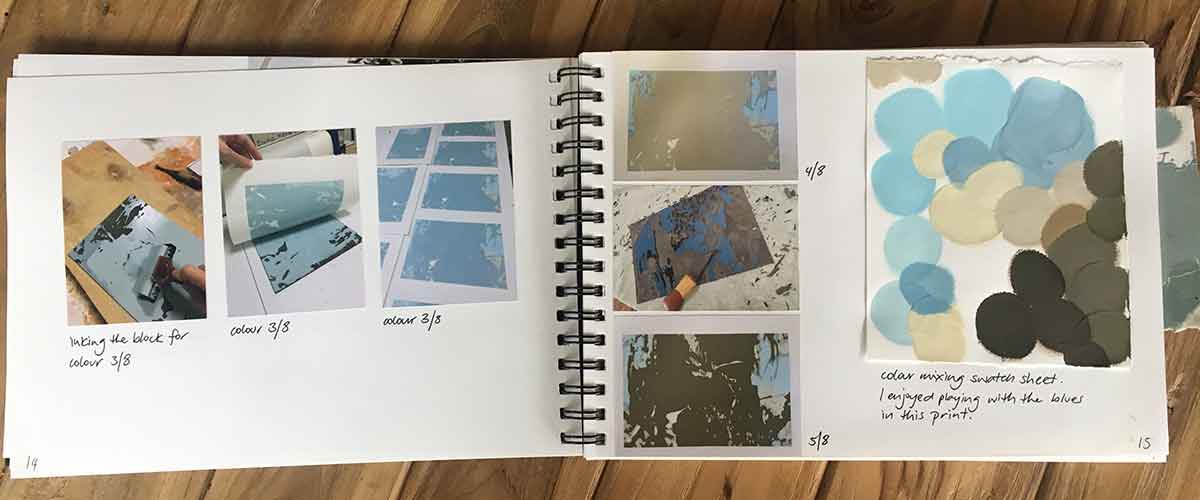
How I shared my printmaking practice in a sketchbook
I have been wanting to create a book that illustrated printmaking processes and the steps I take in my reductive linoprint work. However, I didn’t want it to be colour printouts in plastic sleeves held together in a ring binder. I wanted to create a book where the reader could ‘feel’ connected to the work I do… feel the paper, feel texture on the paper, feel the paper weight when turning pages.
Printmaking is a tactile experience. I love the action of hand printing, inking, carving the lino, caressing the paper.
I recently learned a new word – ‘haptic‘. According to the Oxford dictionary, haptic is defined as:
Relating to the sense of touch, in particular relating to the perception and manipulation of objects using the senses of touch and proprioception.
Then I had to look up the meaning of ‘proprioception‘. Again, according to the Oxford dictionary:
Perception or awareness of the position and movement of the body.
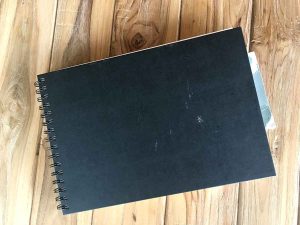 So …
So …
I bought me a sketchbook and set about printing then pasting progress photos of my work, my studio and the tools I use. I have added comments and notes in my own handwriting. The idea is to give people a sneaky peek into my art studio and printmaking practice. I share much of my process online in Instagram and Facebook, and this seemed the most appropriate way to share my printmaking practice.
I often reference the experience of touch when I explain printmaking to people. Touching paper. Hand mixing inks. Holding my carving tools as I carve the lino. Hand rolling ink from the glass to the lino plate. It was important to me to create an experience that involved the sense of touch when people took a look into my studio and printmaking practice.
With my new book, I think I have created a haptic experience, and hopefully something that shares with others my printmaking practice and process.

I started the book with a photo of my studio, taken on the rare and unusual occasion when everything is in its place, and there is surface space beckoning me to start creating and printing my next project.
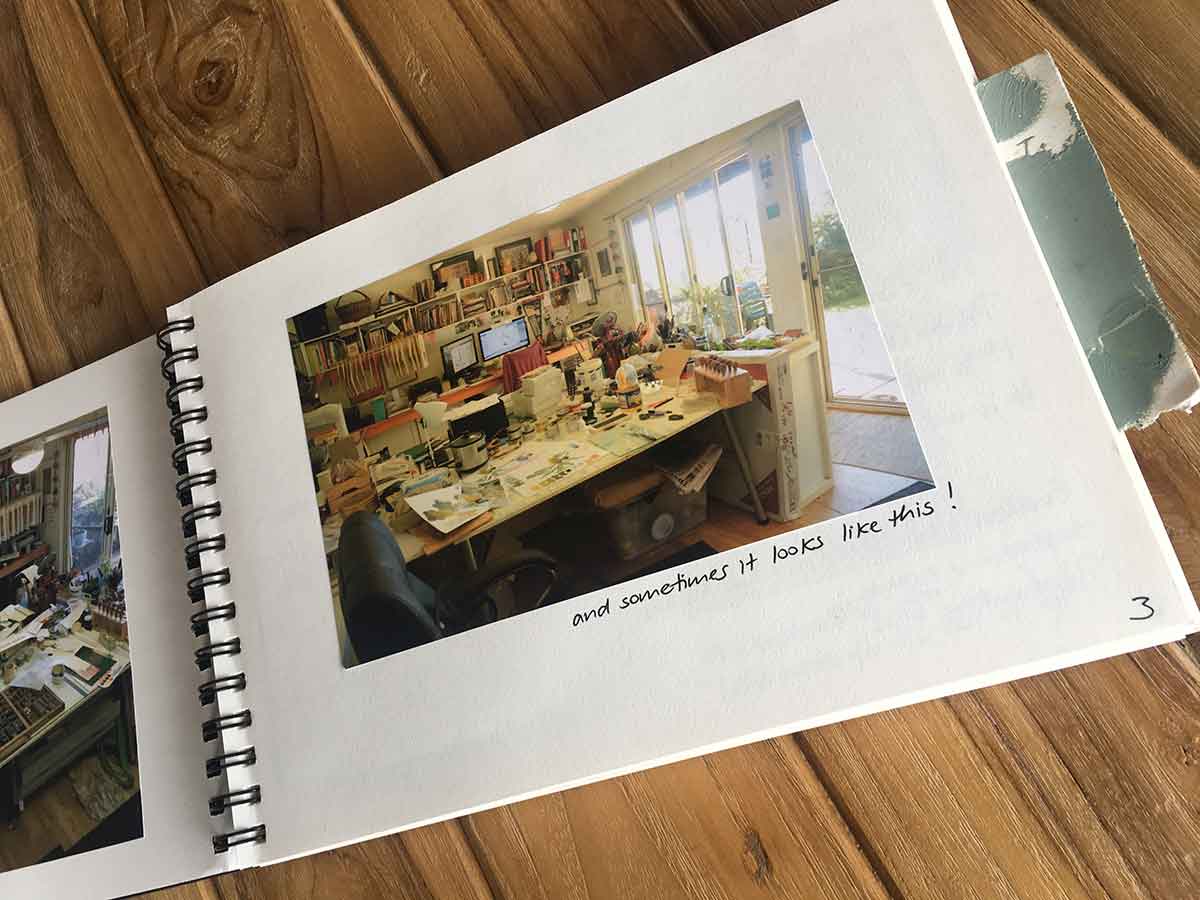
But when you turn the page, you’ll see two photos a little more realistic and honest about the state of the studio on most days!
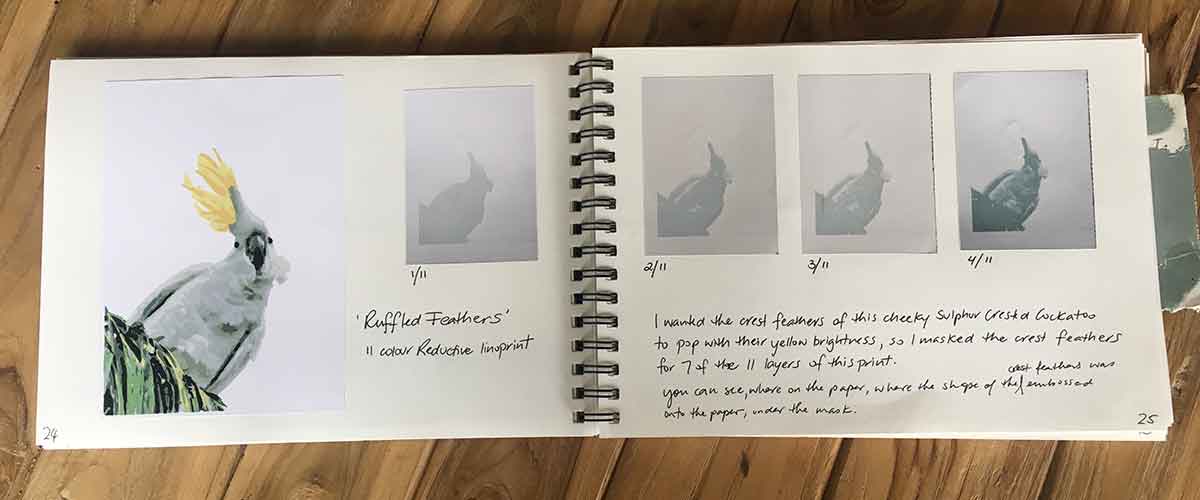
For completed prints I start with a photo of the final print, then show each layer and colour, to the reader can get a sense of the building up of the printed image. Its also a good opportunity to share some insight and personal comments about my thoughts and thinking about the image itself.
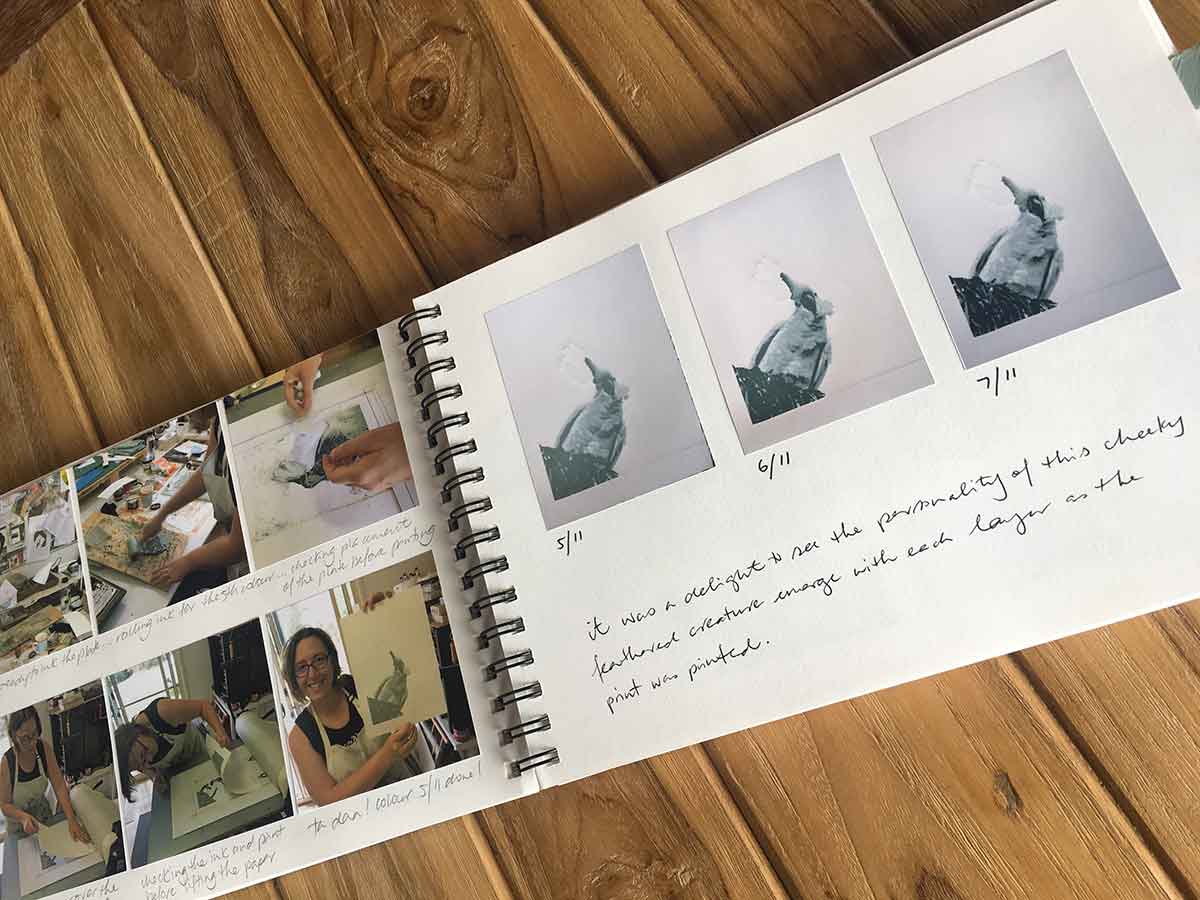
There are pages peppered through the book where I also show ‘action shots’. Photo illustrated pages that work to give the reader a sense of the process in progress.
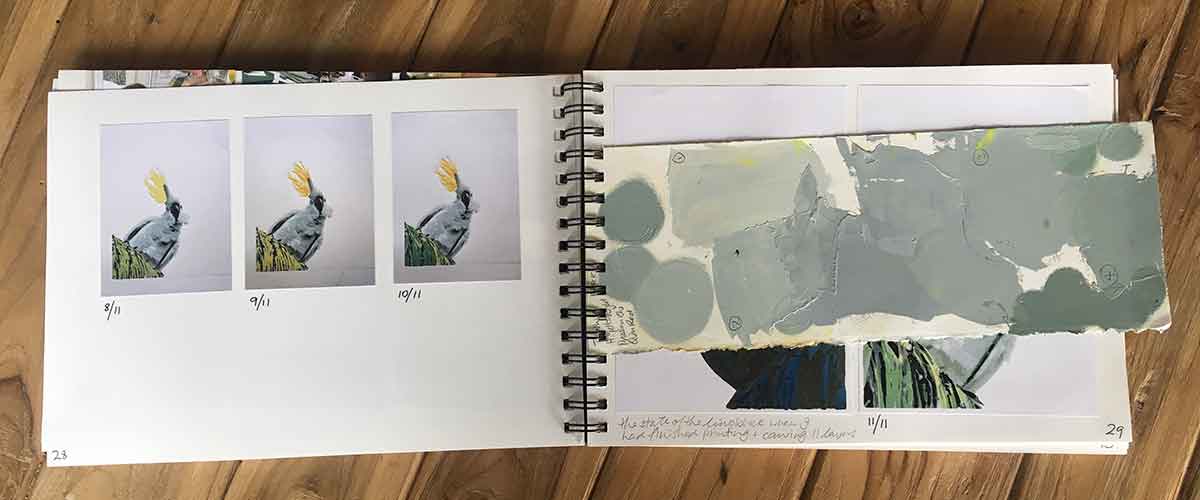
As I print, I have a swatch sheet the same paper that I am printing onto. I use this swatch sheet to check colour matching and coordination. I never throw them away, but until this book, I wan’t quite sure what to do with them. This book provides a perfect place for them. The viewer can touch the ink on the paper. They can see a range of colour mixes. It is my intention that the reader/viewer gains a stronger sense of what is involved in the process. It is my hope that this gives them a stronger connection to my work.
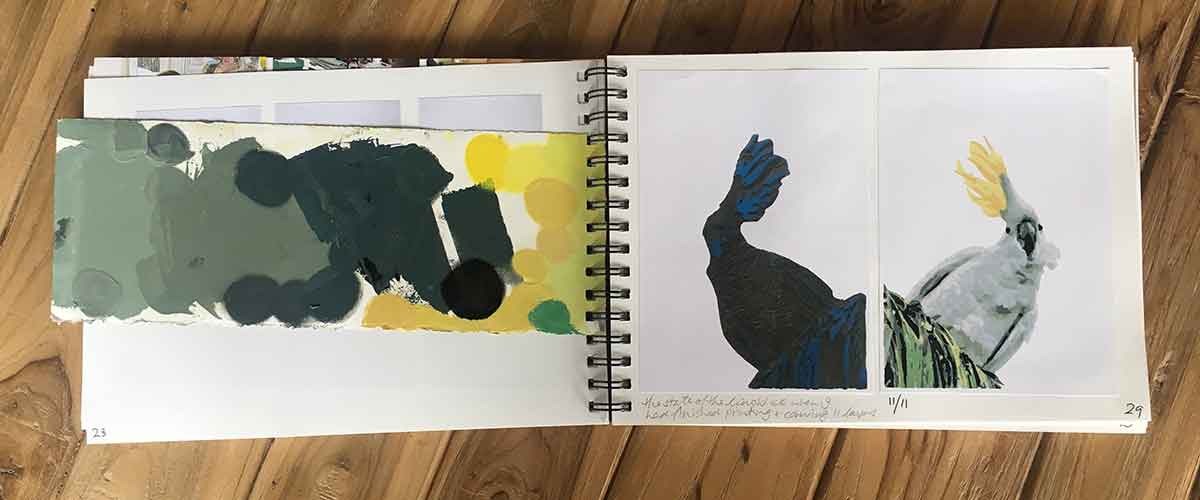
I included a photo of the final state of the block for this Ruffled Feathers print.
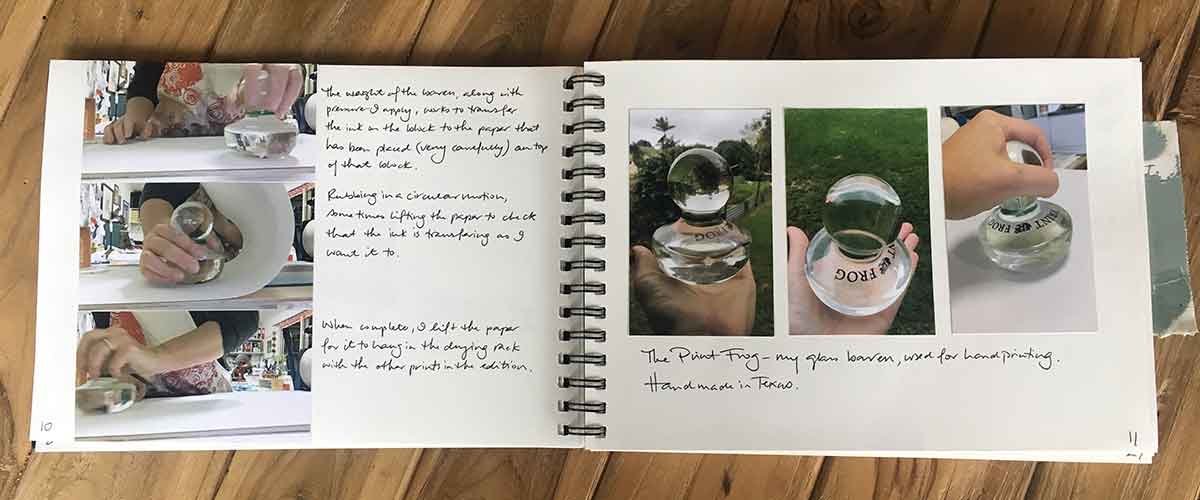
I love my Print Frog! To demonstrate what it is and how I use it, I included photos and a small explanation in my book. I hope that these pages help to demonstrate and explain the handprinting nature of the process.
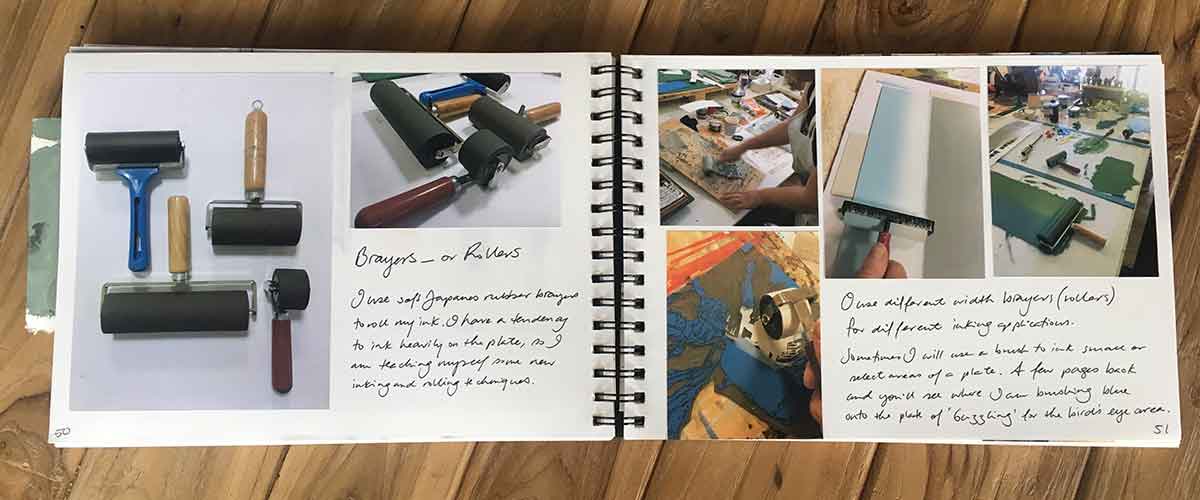
And of course the rollers/brayers. Whether printing with my Print Frog of using my press, my brayers are essential tools in the printmaking process. Sharing photos of the brayers in action I hope helps the viewer get a stronger sense of the process.
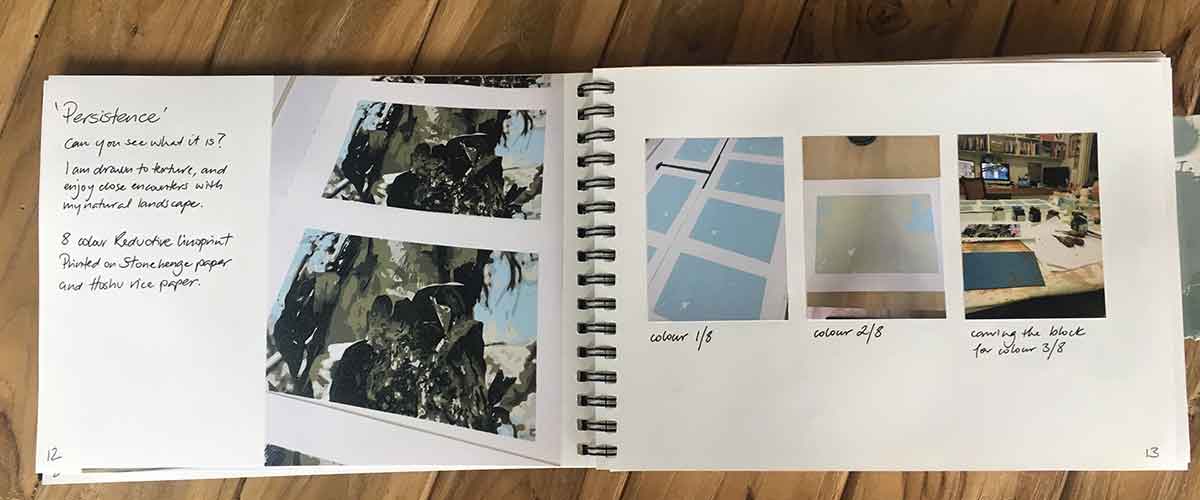
I hope that the picture directly above and below show the process of my ‘Persistence‘ in layers; and also the stages of production for each layer. Again, I was able to include the ink swatch sheet, so people can touch the ink on the paper.

Some notes
I am so used to writing on a keyboard that the book has numerous typos. I did find myself on the odd occasion cursing the fact that there was no spell check for handwriting!
The book is a Work In Progress. As I complete new prints, I will add their progress photos and comments to the book. It is my hope that as and when people return to the gallery, they will be interested to see what is new in the book.
A question
Have you had the same questions? And solved them? (ok, two questions!)
I’d love to hear how you share a bit of yourself and your work with people when you can’t be there in person.





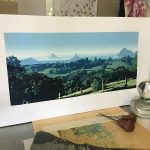
Brilliant. You reveal so much of yourself as well as process in this journal. What an enthusiastic and generous artist you are.
Robby, THANK YOU !! I love to share what I do, and anything about my arts practice that may help and inspire others to let loose and enjoy the creative journey they are on x
Thank you Kim so much as a fellow printmaker from the Central Coast I enjoyed this very much especially since I love and often do birds in my work.
Hi I am a printmaker from the Central Coast and I have used artist talks and powerpoint to let people know the process of printmaking so that this revolves at the exhibition while you are not there I however love books and also appreciate the hands on experience provided by you with the idea of creating a book to view and share the process and really appreciate what goes into printmaking. So thankyou very much love the fact that you have shared your ideas and your art work is great and as I loveeeeeeeeeee cockatoos and birds of all kinds and often have them in my art work I appreciate even more. Thanks Kim.
Hi Therese, thank you for your kind comments. I’m sorry it took me a while to find this comment. My site spammed it. Yes, I think the ‘haptic’ experience of the book works to reinforce the handmade and handprinted nature of the work – well, at least that what I want it to do! I just had a look at your print work. Nice work! Yes, I have a ‘thing’ for birds. It may well be developing into an obsession. I have a few cockatoo prints getting ready for new lino editions.
This is a great idea Kim. Thank you so much for sharing this.
Thank you Sue. I’m glad you enjoyed reading the article. It feel pretty special to know I’ve written something that people have enjoyed.
Good morning Kim, i share your post on FB. I also think art piece are also” what there genesis” (G. Simondon) and it is not so usual to see an artist taking care on the spectator work and not only the technical side.
Thank you De Rette. I enjoy the technical side of my art as much as the aesthetic, and I also enjoy sharing and teaching people about the processes involved.
Your book is so amazing it should be published! But then it wouldn’t be a work in progress as you add more to it! I have a collection of failed prints with notes as to why I think they failed. I hadn’t thought of putting them into a book……
thanks Judy. Your book idea is perfect! I suspect that ‘failed’ may be too harsh a word. I think people love to see the process. Its foreign to many people. And for the people who do know the process, its a delight to see other artists process and progress.
So interesting. I love this. I have what I call my “teaching folder”. Examples that I keep that are examples of something I’ve learnt. (Which, in more than 150 editioned works, are numerous. But I’ve never done more than collate them in huge folders with explanations.
I love the materiality of your creation. It would translate easily into a published book. Have you considered that ?
Thank you Christine. I’m sorry for the late reply – my site spammed your comment! Hmm! I am thinking about a book – something to shows photo-ed demonstration of a range of different printmaking media that I work with. My problem is that when I start a project thinking it will be small, it ends up bigger than Ben Hur! I am really starting to enjoy writing, so maybe this is good encouragement for me.
Hello Kim,
Thank you for this great article. Indeed, we need to explain our processes of work and creation to people. Instagram and Facebook are great tools for sharing daily life in thestudio and work in progress, but your book is a very good idea for exhibitions and/or fairs!
Thank you Raph. I’m looking forward to feedback on how people interact with the book from the gallery its going into.
This is absolutely lovely and inspiring – I’m off to buy a large sketch book and do similarly; to use as my personal journal – maybe share or not.
Thank you, and yay you for getting a sketching yourself a book! I really enjoyed the glueing of the pictures into the book. Its a good reminder of the hard work, lessons learned, and how much you have grown in your practice.
Admiration and respect for your creativity, your love of the print process and your determination to succeed through difficult times.
Thank you Andrina xx
Brilliant idea
Thank you Cheryl. I think its time now to do a new one for my new studio! Your message has been a good reminder fo rme. Thank you x
Thank you Cheryl. I think its time now to do a new one for my new studio! Your message has been a good reminder for me. Thank you x
Thank you Cheryl.